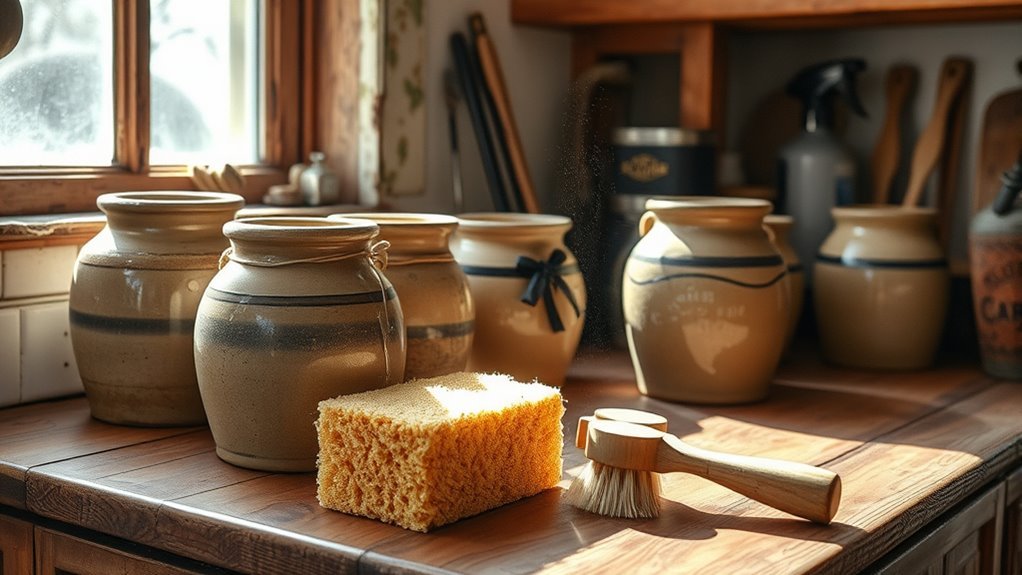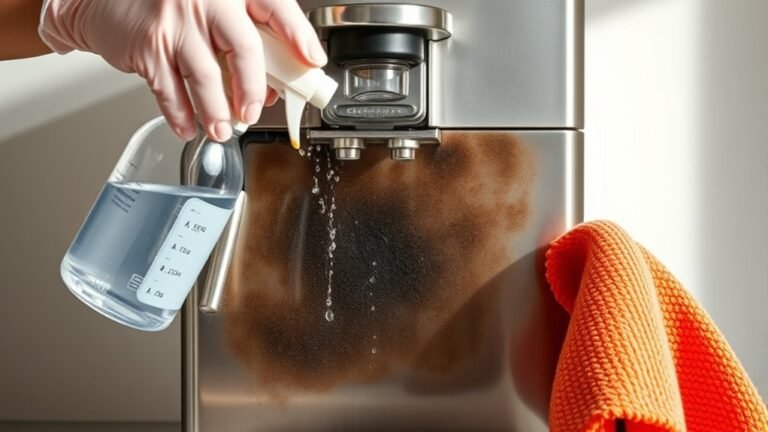How to Clean Antique Stoneware Crocks
To clean antique stoneware crocks, first gather gentle supplies like a soft sponge, baking soda, and a vinegar solution. Rinse your crock with warm water to remove loose debris. Apply a gentle cleaner using a soft cloth, focusing on stained areas. For stubborn stains, use a baking soda paste, letting it sit briefly before scrubbing. Rinse thoroughly, then dry completely to prevent moisture buildup. If you’re curious about additional tips for preserving your antique, there’s more to explore.
Preparation For Cleaning
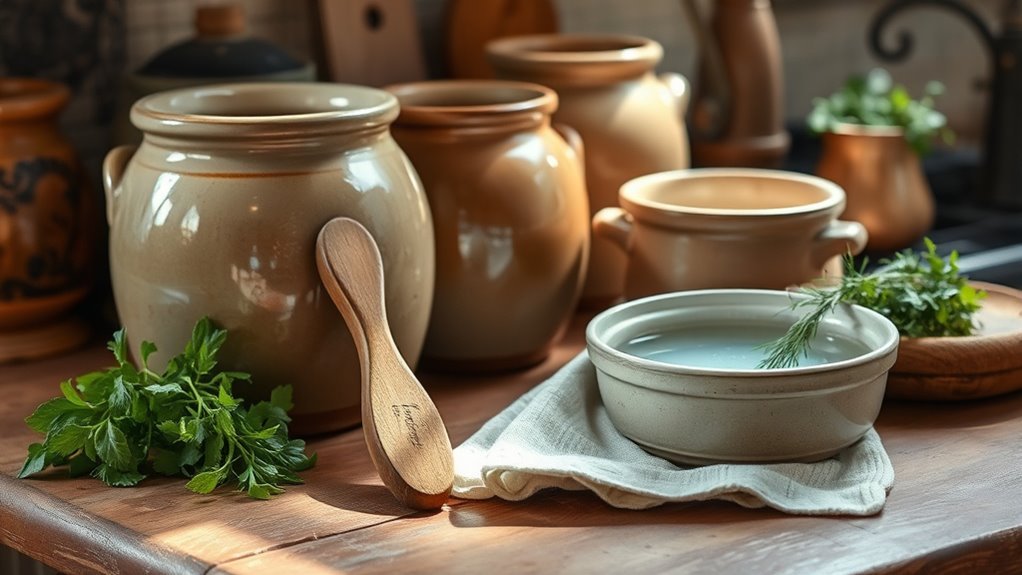
Before you immerse yourself in the cleaning process, it’s crucial to prepare properly. Start by identifying the type of stoneware crock you’re dealing with, as different materials may require specific cleaning techniques. Gather supplies that’ll help you maintain the integrity of the piece, focusing on gentle methods to guarantee antique preservation. Lay down a soft cloth to protect the surface underneath and create a conducive workspace. Assess any visible damage or cracks; document these before you begin. This attention to detail will guide your cleaning efforts and help you avoid exacerbating any issues. Remember, the goal is to refresh your antique without compromising its historical value. With careful preparation, you’ll be ready to proceed with confidence.
Tools and Chemical Required
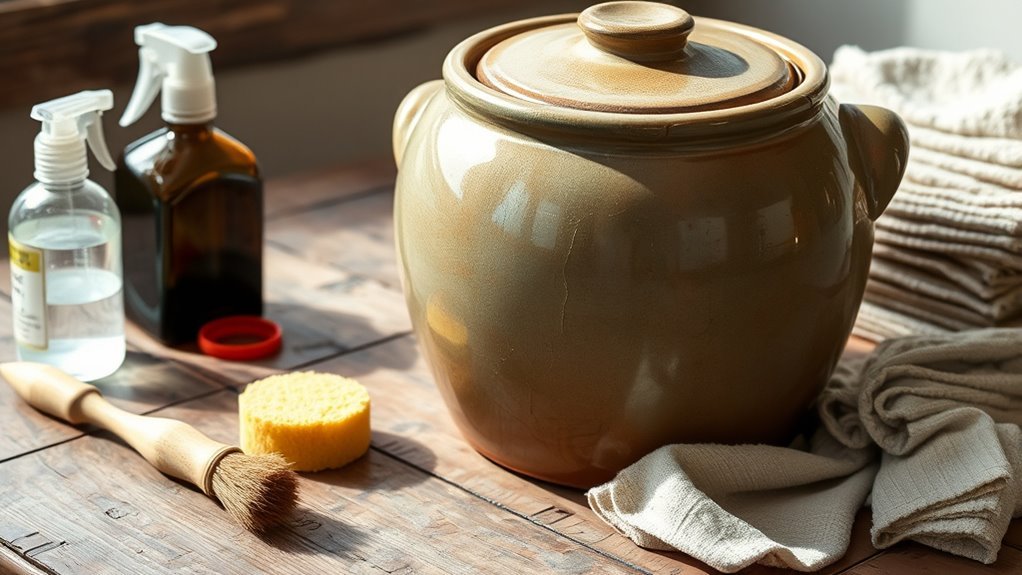
Gathering the right tools and chemicals is essential for effectively cleaning antique stoneware crocks while preserving their integrity. You’ll need a few specific items to guarantee a thorough clean without damaging your treasured pieces.
| Tool/Chemical | Purpose | Suggestions |
|---|---|---|
| Soft sponge | Gentle scrubbing | Avoid abrasive materials |
| Baking soda | Natural cleaning agent | Mix with water for a paste |
| Vinegar solution | Disinfecting solution | Dilute with water |
| Toothbrush | Precision scrubbing | Use for small crevices |
These cleaning solutions and scrubbing tools will help you tackle dirt and stains effectively, all while maintaining the charm of your antique stoneware crocks. Using plant-based cleaners can also ensure that your cleaning routine is safe for both your health and the environment.
How to Clean:
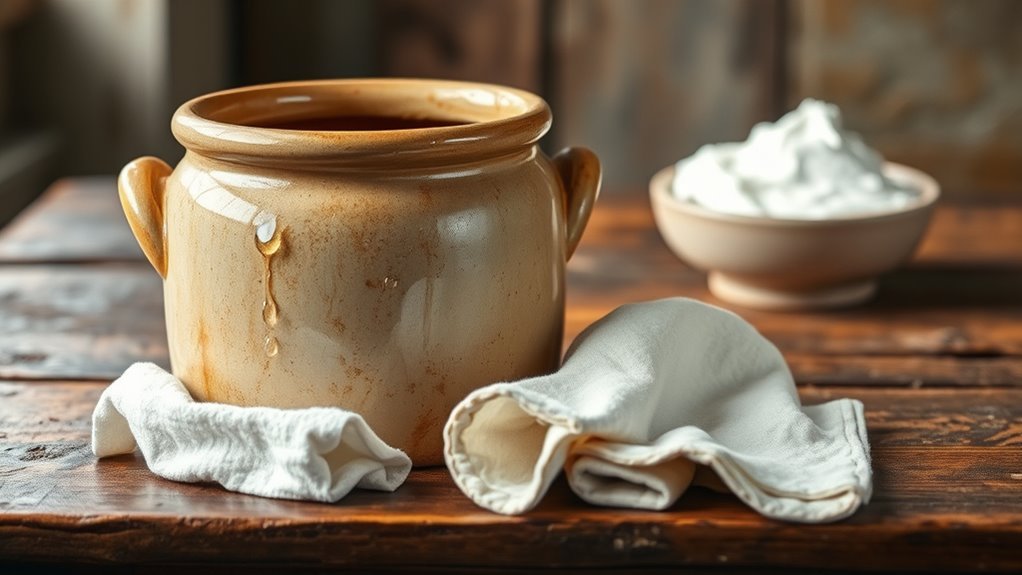
How to Clean Antique Stoneware Crocks
Restoring antique stoneware crocks to their original beauty requires careful attention and the right techniques. Follow this step-by-step guide to ensure your crocks remain in excellent condition.
Step 1: Gather Your Cleaning Materials
- Collect the following items:
- Warm water
- A gentle, non-abrasive cleaner (preferably pH-neutral)
- Soft cloths or sponges
- Baking soda
- A bowl for mixing (if using baking soda)
- A drying cloth
Step 2: Rinse the Crock
- Begin by rinsing the crock under warm running water.
- This step will help remove any loose debris or dirt from the surface.
- Ensure you use warm water, as it helps in loosening grime without harming the glaze.
Step 3: Apply a Gentle Cleaner
- After rinsing, apply a gentle cleaner that is safe for stoneware.
- Avoid harsh chemicals, as they can damage the crock’s glaze and the stoneware itself.
- Use a soft cloth or sponge to apply the cleaner, working in small circles.
Step 4: Focus on Stained Areas
- Pay extra attention to any stained or soiled areas on the crock.
- For these spots, you may need to apply a bit more pressure while still being gentle to avoid scratching.
- If the stains persist, it’s time to prepare a baking soda paste.
Step 5: Create a Baking Soda Paste
- In a bowl, mix baking soda with a small amount of water until it forms a thick paste.
- Apply this paste directly to stubborn stains on the crock.
- Let the paste sit for a few minutes to allow it to break down the stain.
Step 6: Clean the Stained Areas
- Using a soft cloth or sponge, gently scrub the areas where you applied the baking soda paste.
- Work in circular motions, ensuring not to use any abrasive tools that could scratch the surface.
- Rinse the area with warm water to remove the paste and any residue.
Step 7: Rinse Thoroughly
- After cleaning, rinse the entire crock thoroughly with warm water.
- Ensure that no cleaning product or baking soda residue remains on the surface, as these can affect the crock’s appearance and safety for use.
Step 8: Dry the Crock Completely
- Use a drying cloth to wipe down the crock, ensuring it is completely dry.
- This step is crucial to prevent moisture buildup, which can lead to mold or damage over time.
- Allow the crock to air dry in a well-ventilated area if necessary.
Step 9: Regular Maintenance
- To keep your antique stoneware crock looking beautiful, perform regular cleanings.
- Avoid leaving food or liquids in the crock for extended periods.
- Store the crock in a cool, dry place, away from direct sunlight, to maintain its integrity.
Safety Consideration
When handling antique stoneware crocks, it’s essential to prioritize safety to preserve both your health and the integrity of the piece. Start by wearing gloves to protect your skin from any residues or harmful substances that may linger on the surface. If you notice any cracks or chips, take extra care, as these can harbor sharp edges. Use a mask if you’re working in dusty environments to avoid inhaling particles. Also, consider working in a well-ventilated area to minimize exposure to any cleaning agents you may use. Remember, antique preservation isn’t just about the object; it’s about ensuring your well-being while you cherish its history. Taking these health precautions will help you enjoy your collection safely.
Frequently Asked Questions
Can I Use a Dishwasher to Clean Antique Stoneware Crocks?
You shouldn’t use a dishwasher to clean antique stoneware crocks. The high temperatures and harsh detergents can damage the glaze and compromise the integrity of the piece, jeopardizing its value and antique preservation. Instead, gently hand wash them using mild soap and warm water. This method guarantees dishwasher safety while keeping your treasured crocks in excellent condition. Taking the time to care for them properly will allow you to enjoy their beauty for years to come.
How Can I Remove Stubborn Stains From My Crock?
To remove stubborn stains from your crock, start by making a vinegar solution. Mix equal parts vinegar and water in a bowl. Apply it to the stained areas and let it sit for about 15-20 minutes. Then, sprinkle baking soda over the stains. The fizzing reaction helps lift the stains. Gently scrub with a soft cloth or sponge, rinse with warm water, and dry thoroughly to preserve your antique piece’s integrity.
Is It Safe to Use Bleach on Stoneware?
When it comes to using bleach on stoneware, it’s best to tread lightly. Bleach can damage the finish and may lead to unsightly discoloration. Instead, consider bleach alternatives like vinegar or baking soda for cleaning. These options are gentler and preserve your stoneware’s integrity. To keep your crock in tip-top shape, always prioritize stoneware care methods that avoid harsh chemicals, ensuring you can enjoy your cherished pieces for years to come.
Will Cleaning Affect the Value of My Antique Crock?
Yes, cleaning can affect the value of your antique crock. Using harsh cleaning methods can strip away its patina and historical significance. Preservation tips suggest gentle cleaning with mild soap and water, avoiding abrasive materials. Always test any method on a small area first. Maintaining its original look can help retain value, so prioritize preservation over aggressive cleaning. Remember, every crack and mark tells a story that adds to its worth.
Can I Restore a Chipped Stoneware Crock?
Yes, you can restore a chipped stoneware crock using effective repair techniques. Start by cleaning the area around the chip to guarantee good adhesion. Then, use an appropriate epoxy or adhesive specifically designed for ceramics. Apply the chipped repair carefully and allow it to cure as directed. For a seamless look, you might want to paint over the repair with a matching color. This method preserves the crock’s integrity while maintaining its historical charm.
